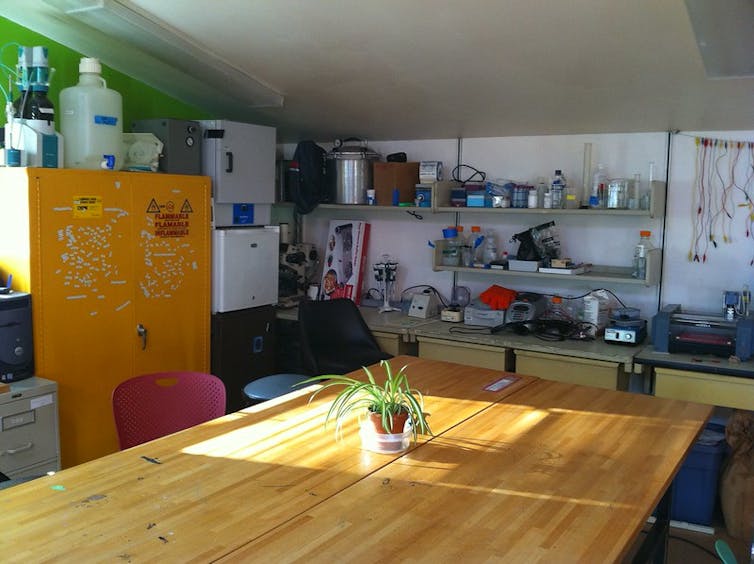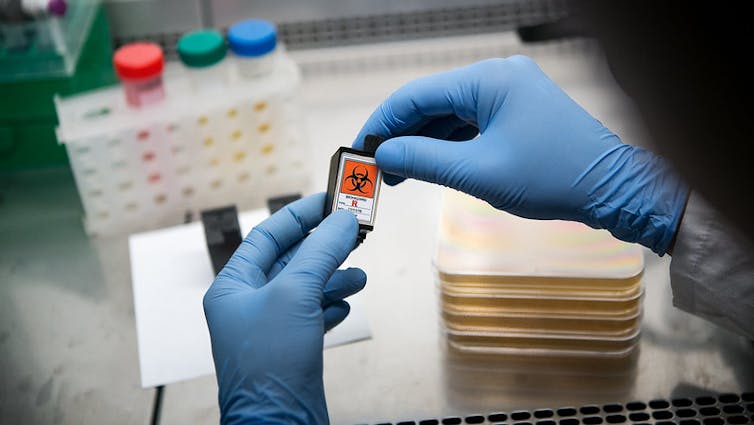Can Scientists Today Bioengineer New Animals Yet
"Jurassic World: Dominion" is hyperbolic Hollywood entertainment at its all-time, with an activeness-packed storyline that refuses to let reality make it the fashion of a skilful story. Nonetheless merely like its predecessors, information technology offers an underlying cautionary tale of technological hubris that'due south very real.
As I discuss in my book "Films from the Hereafter," Stephen Spielberg's 1993 "Jurassic Park," based on Michael Crichton's 1990 novel, didn't shy away from grappling with the dangers of unfettered entrepreneurship and irresponsible innovation. Scientists at the time were getting closer to beingness able to manipulate DNA in the real globe, and both book and movie captured emerging concerns that playing God with nature's genetic code could pb to devastating consequences. This was famously captured by ane of the movie'due south protagonists, Dr. Ian Malcolm, played by Jeff Goldblum, as he declared, "Your scientists were so preoccupied with whether they could, they didn't stop to think if they should."
In the latest iteration of the "Jurassic Park" franchise, lodge is coming to terms with the consequences of innovations that were, at best, sick-conceived. A litany of "coulds" over "shoulds" has led to a future in which resurrected and redesigned dinosaurs roam complimentary, and humanity'southward authorization as a species is under threat.
At the middle of these films are questions that are more relevant than ever: Have researchers learned the lesson of "Jurassic Park" and sufficiently airtight the gap betwixt "could" and "should"? Or will the science and technology of Deoxyribonucleic acid manipulation continue to outpace any consensus on how to utilize them ethically and responsibly?
(Re)designing the genome
The first draft of the human genome was published to great fanfare in 2001, setting the stage for scientists to read, redesign and even rewrite circuitous genetic sequences.
Even so, existing technologies were fourth dimension-consuming and expensive, placing genetic manipulation out of reach for many researchers. The first typhoon of the human being genome cost an estimated Usa$300 million, and subsequent whole-genome sequences merely nether $100 million – a prohibitive amount for all but the most well-funded research groups. As existing technologies were refined and new ones came online, however, smaller labs – and fifty-fifty students and "DIY bio" hobbyists – could experiment more freely with reading and writing genetic lawmaking.

In 2005, bioengineer Drew Endy proposed that it should be possible to work with Dna the same way that engineers work with electronic components. Much as electronics designers are less concerned with the physics of semiconductors than they are with the components that rely on them, Endy argued that information technology should be possible to create standardized Deoxyribonucleic acid-based parts chosen "biobricks" that scientists could utilise without needing to be experts in their underlying biology.
Endy's and others' piece of work was foundational to the emerging field of constructed biology, which applies engineering and design principles to genetic manipulation.
Scientists, engineers and even artists began to approach DNA equally a biological code that could be digitized, manipulated and redesigned in cyberspace in much the aforementioned way every bit digital photos or videos are. This in turn opened the door to reprogramming plants, microorganisms and fungi to produce pharmaceutical drugs and other useful substances. Modified yeast, for example, produces the meaty gustatory modality of vegetarian Incommunicable Burgers.
Despite increasing interest in cistron editing, the biggest barrier to the imagination and vision of the early pioneers of synthetic biology was still the speed and cost of editing technologies.
Then CRISPR changed everything.
The CRISPR revolution
In 2020, scientists Jennifer Doudna and Emanuelle Charpentier won the Nobel Prize in chemistry for their work on a revolutionary new cistron-editing technology that allows researchers to precisely snip out and supersede DNA sequences inside genes: CRISPR.
CRISPR was quick, cheap and relatively piece of cake to use. And it unleashed the imagination of DNA coders.
More than whatever previous advance in genetic engineering science, CRISPR enabled techniques from digital coding and systems engineering to exist applied to biology. This cantankerous-fertilization of ideas and methods led to breakthroughs ranging from using Deoxyribonucleic acid to shop computer data to creating 3D "Dna origami" structures.
CRISPR too opened the mode for scientists to explore redesigning entire species – including bringing back animals from extinction.
Gene drives use CRISPR to directly insert a piece of genetic code into an organism's genome and ensure that specific traits are inherited past all subsequent generations. Scientists are currently experimenting with this applied science to command disease-conveying mosquitoes.
Despite the potential benefits of the engineering science, factor drives raise serious ethical questions. Even when applied to articulate public health threats like mosquitoes, these questions are not easy to navigate. They become fifty-fifty more than complex when because hypothetical applications in people, such as increasing athletic performance in future generations.
Gain of office
Advances in cistron editing accept also fabricated information technology easier to genetically alter the behavior of individual cells. This is at the heart of biomanufacturing technologies that reengineer elementary organisms to produce useful substances ranging from aviation fuel to food additives.
It's besides at the heart of controversies surrounding genetically engineered viruses.
Since the showtime of the pandemic, there have been rumors that the virus that causes COVID-nineteen resulted from genetic experiments gone wrong. While these rumors remain unsubstantiated, they've renewed debate around the ethics of gain-of-function research.

Gain-of-part research uses DNA editing techniques to alter how organisms function, including increasing the ability of viruses to cause disease. Scientists practice this to predict and set up for potential mutations of existing viruses that increase their ability to crusade damage. However, such research also raises the possibility of a dangerously enhanced virus's existence released outside the lab, either accidentally or intentionally.
At the same time, scientists' increasing mastery over biological source code is what has allowed them to quickly develop the Pfizer-BioNTech and Moderna mRNA vaccines to gainsay COVID-19. By precisely engineering the genetic code that instructs cells to produce harmless versions of viral proteins, vaccines are able to prime number the immune system to reply when it encounters the bodily virus.
Responsible biological source code manipulation
Prescient as Michael Crichton was, information technology'southward unlikely that he could have envisioned but how far scientists' abilities to engineer biology have advanced over the past iii decades. Bringing back extinct species, while an active area of research, remains fiendishly hard. However, in many ways, our technologies are substantially further along than those in "Jurassic Park" and the subsequent films.
But how take nosotros done on the responsibility front?
Fortunately, consideration of the social and ethical side of cistron editing has gone manus in hand with the scientific discipline's evolution. In 1975, scientists agreed on approaches to ensure that emerging recombinant Dna enquiry would be carried out safely. From the first, the upstanding, legal and social dimensions of the science were difficult-wired into the Human Genome Project. DIY bio communities have been at the forefront of safe and responsible cistron-editing research. And social responsibility is integral to synthetic biological science competitions.
Yet as gene editing becomes increasingly powerful and accessible, a community of well-pregnant scientists and engineers is unlikely to be sufficient. While the "Jurassic Park" movies take dramatic license in their portrayal of the future, they do go one matter correct: Even with adept intentions, bad things happen when you mix powerful technologies with scientists who haven't been trained to recall through the consequences of their deportment – and haven't thought to ask experts who take.
Perhaps this is the constant bulletin of "Jurassic Earth: Dominion" – that despite incredible advances in genetic design and engineering, things can and will become wrong if we don't embrace the evolution and use of the technology in socially responsible means.
The good news is that we nonetheless take time to shut the gap between "could" and "should" in how scientists redesign and reengineer genetic code. But as "Jurassic Earth: Dominion" reminds moviegoers, the future is oftentimes closer than it might appear.
Source: https://theconversation.com/jurassic-world-scientists-still-havent-learned-that-just-because-you-can-doesnt-mean-you-should-real-world-genetic-engineers-can-learn-from-the-cautionary-tale-184369
Posted by: jacobsoulding.blogspot.com

0 Response to "Can Scientists Today Bioengineer New Animals Yet"
Post a Comment